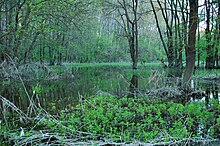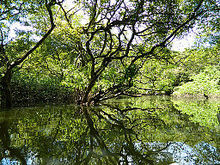Freshwater swamp forest
The article's lead section may need to be rewritten. (January 2024) |

Freshwater swamp forests, or flooded forests, are
Appearance
A freshwater swamp forest is a type of
Beyond these shared characteristics, however, the environment in freshwater swamp forests and other tropical rain forest formations can vary greatly. In inland, freshwater swamp forests, flooding is typically sporadic, irregular, or seasonal. The depth of the water also varies greatly, from a few centimeters to several meters. These physical factors affect the ecology of freshwater swamp forests, either singly or in combination.[5]
Rain, rivers, and groundwater are all sources of water for freshwater swamp forests, whereas rain is the only source of water for peat swamp forests.[6] The hue of the water in the freshwater swamp forest is typically an indication of the quantities of plant materials present in the water and soil.[7] Contrary to ombrotrophic swamp forests, which only absorb nutrients from rain, freshwater swamp forest soils are relatively nutrient-rich.[8] In freshwater swamp forests, rain and changes in the water table result in the following deposition of nutrients and alluvial soils. Due to the nutrient-rich soils of freshwater swamp forests, wetland rice farming and oil palm plantations have become very prevalent in agriculture.[9]
Hydrology
Within aquatic ecosystems, geomorphological, biological, and biogeomorphological processes and functions are significantly influenced by the flow of water.
Flora
The vegetation in freshwater swamp forests is adapted to survive in waterlogged conditions. Common tree species include various types of mangroves, palms, and hardwood trees like mahogany and ebony. The tree canopy tends to be dense and can create a shaded environment beneath.[19]
Biodiversity
Freshwater swamp forests are rich in biodiversity and provide habitat for a wide range of plant and animal species. They support numerous aquatic species, amphibians, reptiles, and mammals. Birds are also abundant in these ecosystems. The flooded conditions can make these areas particularly important for fish breeding and spawning.[20] Fires of various intensities were used in southern Sumatra to burn down the swamp forest to make way for agriculture. There, a rich and complex environment was reduced to a habitat made up of uniform stands of fire-resistant Melaleuca L. species thickets as a result of widespread and frequent fires.[21] Furthermore, improper management of these ecosystems through massive logging and agricultural conversion has resulted in serious deterioration and loss of ecological and biological diversity.[22]
Adaptations
Many plants in freshwater swamp forests have special adaptations to cope with waterlogged soils, such as pneumatophores (aerial roots) in mangroves for oxygen exchange.[23][24] Some animals have adapted to life in these wet environments, like amphibians with permeable skin that can absorb oxygen from water.[25]
Ecosystem services
Freshwater swamp forests offer a variety of ecosystem services. They act as natural buffers against flooding by absorbing excess water during heavy rains. They also filter water, helping to improve water quality by trapping sediments and pollutants.[26] These forests are crucial for carbon sequestration, playing a role in mitigating climate change.[27][28]
Human use
Local communities often rely on freshwater swamp forests for resources such as
Conservation
Freshwater swamp forests are globally important and often designated as protected areas or
Threats
Freshwater swamp forests are vulnerable to habitat destruction and degradation due to urbanization, agriculture, logging, and drainage for development. Climate change, including rising sea levels, can further threaten these ecosystems by altering water levels and salinity.[32]
Freshwater swamp forest ecoregions
Globally, freshwater swamp forests are found in
Freshwater swamp forests are a relatively understudied forest type in Southeast Asia, primarily because they are difficult to access and can
Afrotropic
- Eastern Congolian swamp forests (Democratic Republic of the Congo)
- Niger Delta swamp forests (Nigeria)
- Western Congolian swamp forests (Republic of the Congo, Democratic Republic of the Congo).
Australasia
- Northern New Guinea lowland rain and freshwater swamp forests (Indonesia, Papua New Guinea)
- Southern New Guinea freshwater swamp forests (Indonesia, Papua New Guinea)
South and SE Asia

- Borneo peat swamp forests (Brunei, Indonesia, Malaysia)
- Chao Phraya freshwater swamp forests (Thailand)
- Irrawaddy freshwater swamp forests (Myanmar)
- Peninsular Malaysian peat swamp forests (Malaysia, Thailand)
- Ratargul Swamp Forest (Bangladesh)[40]
- Sundarbans freshwater swamp forests in Bangladesh and India
- Red River freshwater swamp forests (Vietnam)
- Southwest Borneo freshwater swamp forests (Indonesia)
- Tonle Sap-Mekong peat swamp forests (Cambodia, Vietnam)
- Wathurana freshwater swamp forest (Sri Lanka)
- Myristica swamp (India)
- Nelapattu Bird Sanctuary (India)
Neotropic
- Cantão igapó forest (Brazil)
- Gurupa várzea (Brazil)
- Iquitos várzea (Bolivia, Brazil, Peru)
- Marajó várzea (Brazil)
- Monte Alegre várzea (Brazil)
- Orinoco Delta swamp forests (Guyana, Venezuela)
- Pantanos de Centla (Mexico)
- Paramaribo swamp forests (Guyana, Suriname)
- Purus várzea (Brazil)
See also
- Coniferous swamp forest
- Mangrove swamp(saltwater swamp)
References
- ^ "NatureServe Explorer 2.0".
- ^ "NatureServe Explorer 2.0".
- ISBN 978-0-12-145160-8, retrieved 2023-10-04
- ^ Clews, E., Corlett, R. T., Ho, J. K. I., Koh, C. Y., Liong, S. Y., Memory, A., ... & Yeo, D. C. J. (2018). The biological, ecological and conservation significance of freshwater swamp forest in Singapore. Gard. Bull. Singapore, 70(Suppl 1), 9-31.
- ^ Clews, E., Corlett, R. T., Ho, J. K. I., Koh, C. Y., Liong, S. Y., Memory, A., ... & Yeo, D. C. J. (2018). The biological, ecological and conservation significance of freshwater swamp forest in Singapore. Gard. Bull. Singapore, 70(Suppl 1), 9-31.
- ^ Clews, E., Corlett, R. T., Ho, J. K. I., Koh, C. Y., Liong, S. Y., Memory, A., ... & Yeo, D. C. J. (2018). The biological, ecological and conservation significance of freshwater swamp forest in Singapore. Gard. Bull. Singapore, 70(Suppl 1), 9-31.
- ^ Clews, E., Corlett, R. T., Ho, J. K. I., Koh, C. Y., Liong, S. Y., Memory, A., ... & Yeo, D. C. J. (2018). The biological, ecological and conservation significance of freshwater swamp forest in Singapore. Gard. Bull. Singapore, 70(Suppl 1), 9-31.
- ^ Clews, E., Corlett, R. T., Ho, J. K. I., Koh, C. Y., Liong, S. Y., Memory, A., ... & Yeo, D. C. J. (2018). The biological, ecological and conservation significance of freshwater swamp forest in Singapore. Gard. Bull. Singapore, 70(Suppl 1), 9-31.
- ^ Clews, E., Corlett, R. T., Ho, J. K. I., Koh, C. Y., Liong, S. Y., Memory, A., ... & Yeo, D. C. J. (2018). The biological, ecological and conservation significance of freshwater swamp forest in Singapore. Gard. Bull. Singapore, 70(Suppl 1), 9-31.
- ^ Poff, N.L., Allan, J.D., Bain, M.B., Karr, J.R., Prestegaard, K.L., Richter, B.D., Sparks, R.E. & Stromberg, J.C. (1997). The natural flow regime. BioScience 47(11): 769–784.
- ^ Bunn, S.E. & Arthington, A.H. (2002). Basic principles and ecological consequences of altered flow regimes for aquatic biodiversity. Environ. Manage. 30(4): 492–507.
- ^ Poff, N.L. & Allan, J.D. (1995). Functional organization of stream fish assemblages in relation to hydrological variability. Ecology 76(2): 606–627.
- ^ Bunn, S.E. & Arthington, A.H. (2002). Basic principles and ecological consequences of altered flow regimes for aquatic biodiversity. Environ. Manage. 30(4): 492–507.
- ISBN 978-94-007-4001-3, retrieved 2023-10-04
- ^ Clews, E., R. T. Corlett, J. K. I. Ho, C. Y. Koh, S. Y. Liong, A. Memory, S. J. Ramchunder et al. "The biological, ecological and conservation significance of freshwater swamp forest in Singapore." Gard. Bull. Singapore 70, no. Suppl 1 (2018): 9-31.
- ^ Clews, E., Corlett, R. T., Ho, J. K. I., Koh, C. Y., Liong, S. Y., Memory, A., ... & Yeo, D. C. J. (2018). The biological, ecological and conservation significance of freshwater swamp forest in Singapore. Gard. Bull. Singapore, 70(Suppl 1), 9-31.
- ^ Corlett, R.T. (1986). The mangrove understory - some additional observations. J. Trop. Ecol. 20(1): 93–94.
- ^ Clews, E., Corlett, R. T., Ho, J. K. I., Koh, C. Y., Liong, S. Y., Memory, A., ... & Yeo, D. C. J. (2018). The biological, ecological and conservation significance of freshwater swamp forest in Singapore. Gard. Bull. Singapore, 70(Suppl 1), 9-31.
- ISBN 978-3-642-41554-8, retrieved 2023-10-04
- ^ "Mangroves trees and shrubs". www.fao.org. Retrieved 2023-10-04.
- ^ Clews, E., Corlett, R. T., Ho, J. K. I., Koh, C. Y., Liong, S. Y., Memory, A., ... & Yeo, D. C. J. (2018). The biological, ecological and conservation significance of freshwater swamp forest in Singapore. Gard. Bull. Singapore, 70(Suppl 1), 9-31.
- ^ Clews, E., Corlett, R. T., Ho, J. K. I., Koh, C. Y., Liong, S. Y., Memory, A., ... & Yeo, D. C. J. (2018). The biological, ecological and conservation significance of freshwater swamp forest in Singapore. Gard. Bull. Singapore, 70(Suppl 1), 9-31.
- ISBN 978-3-642-41554-8, retrieved 2023-10-04
- ^ "Trees of the Mangroves". Trees of the Mangroves. Retrieved 2023-10-04.
- JSTOR 1931435.
- ISSN 1051-0761.
- ^ Hawes, E., & Smith, M. (2005). Riparian buffer zones: Functions and recommended widths. Eightmile River Wild and Scenic Study Committee, 15, 2005.
- ISSN 1051-0761.
- ISSN 1687-9368.
- S2CID 241274254, retrieved 2023-10-05
- ^ "Ecology of Wetland Ecosystems: Water, Substrate, and Life | Learn Science at Scitable". www.nature.com. Retrieved 2023-10-05.
- PMID 19700447.
- ^ Clews, E., Corlett, R. T., Ho, J. K. I., Koh, C. Y., Liong, S. Y., Memory, A., ... & Yeo, D. C. J. (2018). The biological, ecological and conservation significance of freshwater swamp forest in Singapore. Gard. Bull. Singapore, 70(Suppl 1), 9-31.
- ^ Clews, E., Corlett, R. T., Ho, J. K. I., Koh, C. Y., Liong, S. Y., Memory, A., ... & Yeo, D. C. J. (2018). The biological, ecological and conservation significance of freshwater swamp forest in Singapore. Gard. Bull. Singapore, 70(Suppl 1), 9-31.
- ^ Clews, E., Corlett, R. T., Ho, J. K. I., Koh, C. Y., Liong, S. Y., Memory, A., ... & Yeo, D. C. J. (2018). The biological, ecological and conservation significance of freshwater swamp forest in Singapore. Gard. Bull. Singapore, 70(Suppl 1), 9-31.
- ISBN 978-94-007-0145-8.
- S2CID 53046359.
- ^ Clews, E., Corlett, R. T., Ho, J. K. I., Koh, C. Y., Liong, S. Y., Memory, A., ... & Yeo, D. C. J. (2018). The biological, ecological and conservation significance of freshwater swamp forest in Singapore. Gard. Bull. Singapore, 70(Suppl 1), 9-31.
- ^ "Swamp Forest - an overview | ScienceDirect Topics".
- ^ "Swamp Forest Ratargul : Amazon of Bangladesh ~ Beautiful Bangladesh".


